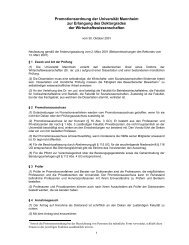The returns to cognitive and non-cognitive abilities in Germany
The returns to cognitive and non-cognitive abilities in Germany
The returns to cognitive and non-cognitive abilities in Germany
Create successful ePaper yourself
Turn your PDF publications into a flip-book with our unique Google optimized e-Paper software.
solv<strong>in</strong>g tasks that are related <strong>to</strong> new material. <strong>The</strong> test was implemented ask<strong>in</strong>g respondents<br />
<strong>to</strong> match as many numbers <strong>and</strong> symbols as possible with<strong>in</strong> 90 seconds accord<strong>in</strong>g <strong>to</strong> a given<br />
correspondence list which is visible <strong>to</strong> the respondents on a screen.<br />
Both tests were previously shown <strong>to</strong> produce outcomes which are sufficiently<br />
correlated with test scores of more comprehensive <strong>and</strong> well-established <strong>in</strong>telligence tests<br />
(Lang, 2005; Lang et al., 2007). However, we decided <strong>to</strong> employ the SCT scores only. We<br />
do not use test scores from the word fluency test s<strong>in</strong>ce the nature of this test <strong>in</strong>terferes with<br />
the concept of crystallized <strong>in</strong>telligence <strong>in</strong>asmuch as fac<strong>to</strong>rs like for example work<strong>in</strong>g<br />
memory come <strong>in</strong><strong>to</strong> play because of the time constra<strong>in</strong>t. Work<strong>in</strong>g memory however is related<br />
<strong>to</strong> executive function <strong>and</strong> thus <strong>to</strong> fluid <strong>in</strong>telligence rather than crystallized <strong>in</strong>telligence only.<br />
<strong>The</strong>refore, <strong>in</strong> order <strong>to</strong> have a clean measure <strong>in</strong>stead of a mixture of different concepts, we<br />
concentrate on the SCT as a pure measure of fluid <strong>in</strong>telligence. <strong>The</strong> focus on the SCT is<br />
further justified by the word fluency test be<strong>in</strong>g more affected by measurement error, as the<br />
<strong>in</strong>terviewer has <strong>to</strong> identify <strong>in</strong>stantly duplicate entries when count<strong>in</strong>g the animal names stated<br />
by the respondent Moreover, this approach also allows us <strong>to</strong> <strong>in</strong>clude <strong>in</strong>dividuals with<br />
migration background who may have <strong>in</strong>sufficient language skills <strong>and</strong> hence be<br />
disadvantaged compared <strong>to</strong> native speakers when tak<strong>in</strong>g the test.<br />
Measures of personality<br />
<strong>The</strong> 2005 wave of the SOEP provides several measures of <strong>in</strong>dividuals’ personality.<br />
First, there are items that relate <strong>to</strong> the Five Fac<strong>to</strong>r Model (McCrae <strong>and</strong> Costa, 1996; 1999)<br />
compris<strong>in</strong>g the five basic psychological dimensions as outl<strong>in</strong>ed above: openness <strong>to</strong><br />
experience, conscientiousness, extraversion, agreeableness, <strong>and</strong> neuroticism. S<strong>in</strong>ce extensive<br />
psychological question<strong>in</strong>g was not feasible <strong>in</strong> the SOEP, 6 the data provides a set of fifteen<br />
items (listed <strong>in</strong> Table A1 <strong>in</strong> the Appendix) of which three each are <strong>to</strong> capture the respective<br />
13















